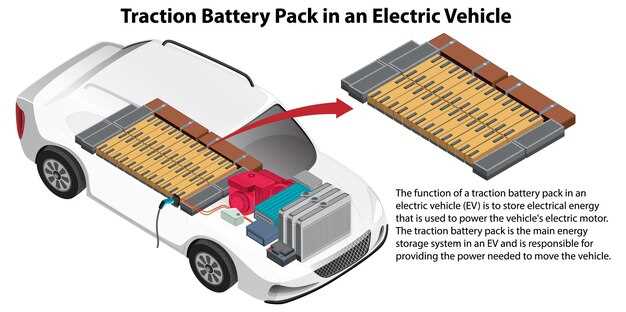When to replace your car battery

Your car battery is an essential component of your vehicle’s functionality, providing the necessary power to start your engine and run various electrical systems. Over time, batteries can degrade due to several factors, including age and environmental conditions. Recognizing the signs that indicate a need for replacement is crucial to ensuring your vehicle operates smoothly and reliably. In this article, we will explore key indicators that it might be time to replace your car battery, along with practical tips to help you make the best decision.
Understanding the longevity and performance of your auto battery is key to maintaining a safe driving experience. A well-functioning battery should last anywhere from three to five years, but certain symptoms may point to an impending failure. From dimming headlights to difficulty starting your engine, these warning signs can save you from being stranded due to a dead battery. Stay tuned as we delve deeper into these signs to help you identify when it’s time to take action and replace your battery.
Identifying Common Warning Signs of Battery Failure

Recognizing the signs of a failing car battery is crucial for preventing unexpected breakdowns and ensuring reliable vehicle performance. Here are some essential tips to help you identify when a replacement battery may be necessary:
1. Slow Engine Crank: If your engine takes longer than usual to start, it’s a strong indication that the battery is losing its charge. A sluggish crank can be a precursor to complete battery failure.
2. Dimming Lights: Notice whether your headlights or dashboard lights appear dimmer than normal, especially when idling. This symptom can suggest that your battery is unable to provide adequate power.
3. Electrical Issues: Problems with electrical components, such as power windows or a malfunctioning radio, can signal battery trouble. If these systems are acting erratically, it may be time for a battery replacement.
4. Corroded Connectors: Inspect the battery terminals for any signs of corrosion, including a white, powdery substance. Corroded connections can hinder the battery’s performance and require immediate attention.
5. Check Engine Light: A sudden appearance of the check engine light can indicate various issues, including battery problems. It’s advisable to have your battery and electrical system checked when this light illuminates.
6. Age of the Battery: If your battery is over three to five years old, it might be nearing the end of its life cycle. Consider replacing it preemptively to avoid being stranded.
Regular maintenance and attention to these warning signs will help you ensure that your vehicle remains reliable. If you notice any of these symptoms, consult a professional for a thorough battery assessment and consider a prompt replacement.
Understanding Battery Health Through Testing Techniques

Regular assessment of your auto battery’s health is crucial for determining when a replacement is necessary. Several testing techniques can provide insights into the condition and performance of your battery. Here are some effective methods:
- Voltage Test: A basic method to check battery health is measuring its voltage. A fully charged battery should read between 12.6 and 12.8 volts. If readings drop below 12.4 volts, it may indicate the need for replacement.
- Load Test: This test simulates the actual conditions when starting your vehicle. A load tester applies a specified load to the battery while monitoring the voltage. If the voltage falls below 9.6 volts during the test, it’s a signal that replacement is likely needed.
- Conductance Test: Utilizing a specialized tool, a conductance test evaluates the battery’s ability to conduct electrical current. This method is quick and can provide a clear indication of battery health. Values below the manufacturer’s specified range typically suggest it’s time for a replacement.
- Hydrometer Test: For lead-acid batteries, a hydrometer measures the specific gravity of the electrolyte. This can help assess the state of charge. A low reading may reveal sulfation or other issues that could necessitate a replacement.
Understanding these testing techniques can help vehicle owners maintain their auto batteries effectively. Regular testing not only extends the life of your battery but also ensures reliable performance for your vehicle.
Steps to Safely Replace Your Car Battery
Replacing your car battery is a straightforward process, but it’s essential to follow safety precautions to avoid accidents. Begin by gathering the necessary tools: a wrench, safety glasses, and gloves. Ensure that your vehicle is parked on a flat surface with the engine turned off and the keys removed from the ignition.
Next, open the hood and locate the battery. Before disconnecting the old battery, identify the positive and negative terminals, usually marked with “+” and “-“. Start by removing the negative terminal first using your wrench. This step reduces the risk of electrical shock or short-circuiting. Afterward, disconnect the positive terminal in the same manner.
Once both terminals are disconnected, carefully remove any clamps or brackets holding the battery in place. Batteries can be heavy, so use both hands when lifting to avoid injury. Place the old battery aside and prepare to install the new one.
Before placing the new battery in the vehicle, ensure it is the correct type for your auto. Position the new battery in the battery tray, making sure it aligns properly. Reattach the clamps or brackets for security. Begin the connection process by attaching the positive terminal first, followed by the negative terminal. This order helps prevent electrical issues.
Finally, give the battery a gentle shake to ensure it’s secure and everything is connected tightly. Close the hood, start the engine, and check that all electrical components are functioning correctly. Properly dispose of the old battery at a recycling center to ensure environmental safety.

